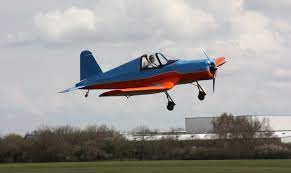Three companies presented electric versions of their light electric aircraft at Friedrichshafen, Germany this year. From a WWII replica to a high- and low-wing pair of Part 103-compliant craft, to a very modern trainer, the three represent increasing sophistication in light aircraft.
Elektra Trainer
Dr. Birgit Weissenbach shared that as the only approved electric aircraft in its class, the Elektra Trainer also gained Aero Expo’s Innovation Award 2023 from Aerokurier. We’ve described the technical details of the airplane in a February entry about its certification, and highlighted its development through many other entries.
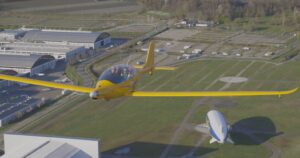
Elektra Trainer over Aero Expo at Friedrichshafen, Germany
Dr. Wiessenbach noted,“What is particularly pleasing is that this year’s reader award was drawn not only among electric aircraft, of which there are currently not that many, but in the much larger category engine and electric aircraft.
Its promised “2.5 hours of safe flight,” validated noise level of 48 dBa, and relatively easy one-person assembly all add up to a functional, useful trainer that can lower the cost of instruction for new pilots. This may have helped seal at least one deal at Aero Expo. We hope for more such sales. Couple that to a solar-powered trailer in which the trainer can be kept and one has a highly self-sufficient mode of flight. Calin Gologan, designer and head of Elektra Solar (and Dr. Weissenbach’s husband) has developed a trailer that allows up to 400 hours a year of truly free flight.
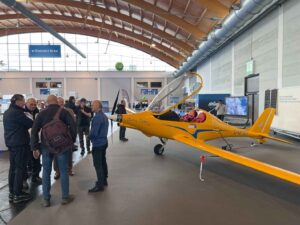
Elektra Trainer drew attention, and customers to its stand at Aero Expo
As Elektra Solar explains, “Flight schools and airfield operators are concerned about the secure future of their flight operations in view of climate change and the associated effects. The rethinking of sustainable and quiet flight operations has already begun”
AVI Aircraft
Mr. Radu Berceanu – AVI Group’s owner and President heads the airplane element of the Romanian company that has 35 years experience in crafting everything from composite swimming pools to mailboxes and components for land and sea transport.
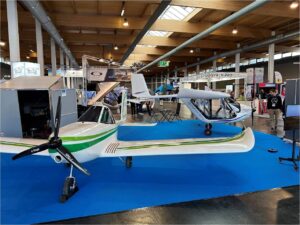
Electric Dracula in foreground with gas-powered Swan in background. Both can use gas or electric power
Berceanu works with two basic product line, the Swan and the Dracula, high-wing and lowing ULMs (Ultra Light Motorized) aircraft. Such machines fit neatly into the FAA;s Part 103 designation, and both can be electrified. Even more tantalizing, these ready-to-fly ultralights can be purchased for prices “in the $30,000s,” according to Dan Johnson. (Be warned, though, that shipping and handling can add less tempting figures to the sale price.)
Dan Johnson, on his web site, includes a note that either machine can “fit in an impossibly small trailer, after removing both wings and tail feathers, and then folding the tail boom. That allows the compact mass to fit into a trailer “6 feet wide by 12 feet long by 6.5 feet high, which is the box size of a standard 6×12 enclosed trailer.” He lists the following specification – not bad for ultralights:
both models share specifications provided by the factory
- Maximum Takeoff Weight — 529 pounds (240 kilograms)
- Takeoff roll on grass runway — < 295 feet (90 meters)
- Maximum Crosswind — < 18 miles per hour (30 kilometers per hour)
- Climb Rate — > 600 feet per minute (3 meters per second)
- Cruise Speed — < 68 miles per hour (110 kilometers per hour)*
- Never Exceed Speed — < 93 miles per hour (150 kilometers per hour)
- Limit Loads — +4, –2 G
- Best Glide Ratio — 10:1 at 53 miles per hour (85 kilometers per hour)
- Motor — 28 kW maximum power, 100 V, 102 kgs maximum thrust
- Batteries — 4 X 2.66 kWh each
- Charging — from 25% to 100% in 4.5 hours at 230V/16A
- Duration — minimum 1 hour of flight with reserve
Part 103-Eligible Corsair
Making an Ultralight Corsair may seem like an unlikely prospect, but Jorg Hollmann (as in JH Aircraft) has made a grand kit-built possibility of it. His bent-wing bird is certified as an ultralight in France, and meets most criteria for Part 103 status in America. Its amazing empty weight of 187 pounds (with0ut batteries) testifies to some clever engineering. That the structure can demonstrate static loads of +6 and -4 G’s is truly remarkable.
Originally flown with a three-cylinder radial, two-stroke engine, Jorg has added an electric motor option to the JH lineup.
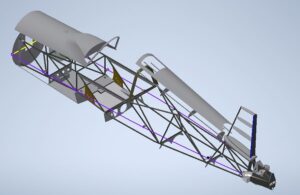
A carbon fiber space frame forms the basis for the e-Corsair’s remarkable light weight structure
Even though it emulates the looks of a dangerous WWII fighting craft, the e-Corsair features a Kevlar-reinforced safety cell and a ballistic parachute – a requirement in its native Germany.
Sharing an Eck-Geiger motor with AVI’s electric ultralights, the Corsair can hold up to four small battery packs which can deliver up to 14 kilowatt hours of energy four up to two hours of flight.
| Wing span – with folded wings |
24,6 ft 9,0 ft |
| Length | 20,7 ft |
| Wing area | 108 sq ft |
| Empty weight without batteries | 187 lbs |
| Payload | 364 lbs |
| Safe loading | +6g / -4g |
| Engine | Electric motor HPD16 or HPD20 |
| Power | 16 kWc / 20 kWpeak or 20 kWc / 30 kWpeak |
| Batteries | 7, 10 or 14 kWh, max 136 lbs |
| Flight time | Up to 2 hours (14 kWh) |
| Take off roll distance | < 130 ft |
| Take off over 50 ft obstacle | < 400 ft |
| Stall speed | 30 knots |
| Cruise speed | 86 knots |
| Maximum speed | 108 knots |
| Best climb | 1200 ft/min |
All three aircraft show what can be done with careful design and attention to detail. That they can provide budget flying on electric power only adds to their environmentally solid character.

